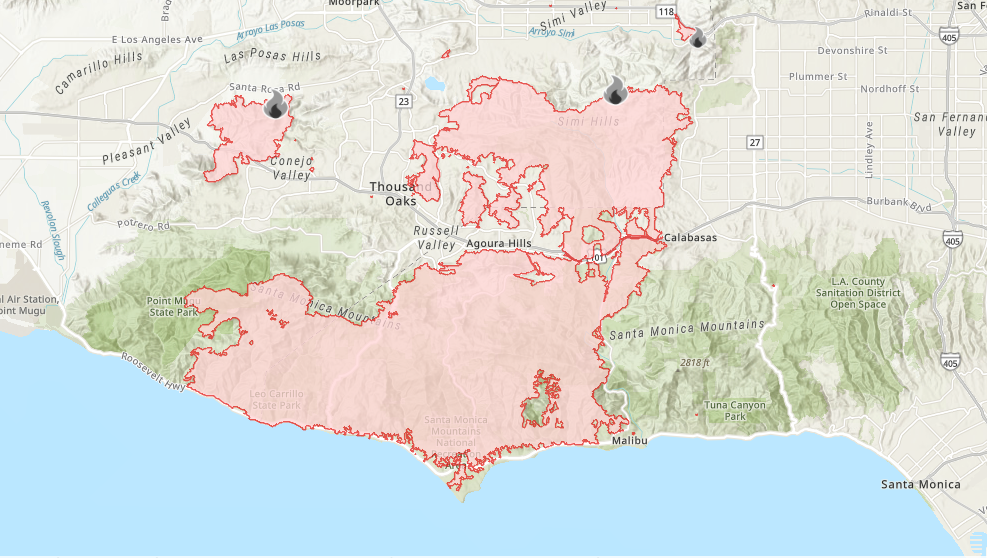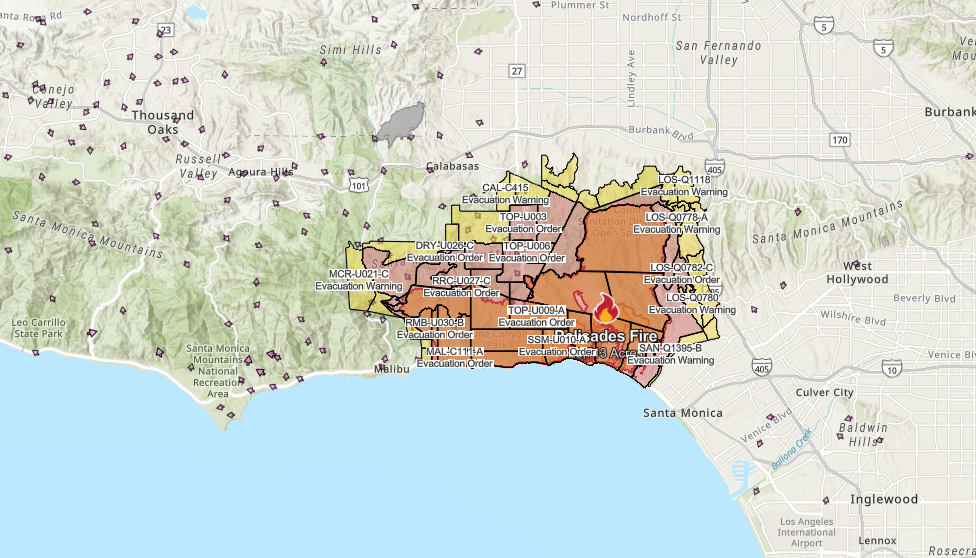Woolsey Fire (California, 2018)
1. Number of Acres Burned
- Approximately 96,949 acres were consumed by the fire.
2. Causes Leading to the Fire
- The fire was ignited on November 8, 2018, near the Santa Susana Field Laboratory in Ventura County.
- Investigations revealed that Southern California Edison (SCE) equipment likely contributed to sparking the fire.
- Contributing factors included:
- Dry conditions due to an ongoing drought.
- Strong Santa Ana winds, which spread the flames rapidly.
- Dense vegetation and buildup of flammable materials in the region.
3. Period of Duration
- The fire lasted from November 8, 2018, to its full containment on November 21, 2018 (13 days).
4. Monetary Damage
- Estimated $6 billion in damages, including both insured and uninsured losses.
- 1,643 structures were destroyed, and 364 structures were damaged.
5. Number of People That Died
- 3 fatalities were reported.
- Numerous injuries were reported among both civilians and firefighters.
6. Success Factors in Firefighting Efforts
- Deployment of over 3,000 firefighters from multiple agencies.
- Effective use of aerial firefighting resources, including planes and helicopters.
- Emergency response teams implemented extensive evacuation measures, which likely saved lives.
- Coordination between local, state, and federal agencies.
7. Points of Failure
- The fire spread rapidly due to inadequate vegetation management and dry, windy conditions.
- Aging power infrastructure contributed to the ignition.
- Challenges in emergency communication delayed some responses.
- Limited access to remote areas hampered initial firefighting efforts.
- Some residents reported inadequate warning before the fire reached their communities.
Palisades Fire (California, 2024)
1. Number of Acres Burned
- The fire consumed approximately 23,713 acres in the Santa Monica Mountains, affecting areas such as Pacific Palisades, Topanga, and Malibu.
2. Causes Leading to the Fire
- The exact cause is currently under investigation.
- Contributing factors included:
- Extreme Santa Ana winds, with gusts up to 70 mph, which exacerbated the fire’s spread.
- Drought conditions, with the region experiencing eight months without measurable rainfall, leading to dry vegetation.
3. Period of Duration
- The fire ignited on January 7, 2025, and as of January 15, 2025, it was 21% contained.
4. Monetary Damage
- The fire resulted in an estimated $50 billion in economic losses, including property damage and business disruptions.
- Approximately 12,000 structures were destroyed.
5. Number of People That Died
- At least 10 fatalities were reported.
6. Success Factors in Firefighting Efforts
- Deployment of thousands of firefighters, including personnel from other states and countries.
- Establishment of Disaster Resource Centers to assist affected residents.
7. Points of Failure
- The rapid spread due to strong winds and dry conditions challenged containment efforts.
- Some residents reported inadequate warning before the fire reached their communities.
Eaton Fire (California, 2024)
1. Number of Acres Burned
- The fire burned approximately 14,117 acres in the Altadena area, including parts of Pasadena and the San Gabriel Mountains.
2. Causes Leading to the Fire
- The cause is currently under investigation.
- There are allegations against Southern California Edison (SCE) for negligence in handling power safety shut-offs, potentially contributing to the fire’s ignition.
3. Period of Duration
- The fire started on January 7, 2025, and as of January 11, 2025, it was 15% contained.
4. Monetary Damage
- Approximately 8,690 structures were destroyed, with an estimated $50 billion in economic losses.
5. Number of People That Died
- At least 17 fatalities were reported.
6. Success Factors in Firefighting Efforts
- Evacuation orders were promptly issued for affected areas, including Altadena, Pasadena, and surrounding communities.
- Community support initiatives, such as local chefs providing meals to evacuees and first responders.
7. Points of Failure
- Challenges in evacuating vulnerable populations, leading to tragic incidents.
- Criticisms regarding the handling of power safety shut-offs by utility companies.


Similarities (Woolsey and Pacific Palisades)
1. Environmental and Climatic Conditions
- Drought Conditions: All three fires occurred during prolonged periods of drought, resulting in extremely dry vegetation that fueled the spread of the fires.
- Strong Winds:
- Woolsey Fire: Driven by Santa Ana winds with gusts exceeding 70 mph.
- Eaton Fire and Pacific Palisades Fire: Similarly influenced by high Santa Ana winds that spread flames rapidly.
- High Temperatures: Hot, dry weather created the ideal conditions for the fires to ignite and spread.
2. Human Factors as Causes
- Utility Equipment Failures:
- Woolsey Fire: Sparked by Southern California Edison equipment.
- Eaton Fire and Pacific Palisades Fire: Also suspected to involve negligence or equipment failures by Southern California Edison (under investigation for the 2025 fires).
- Delayed Mitigation Efforts: Utility companies faced criticism in all three cases for failing to proactively manage power safety shut-offs or maintain infrastructure.
3. Scale and Damage
- Large Areas Burned: Each fire consumed tens of thousands of acres:
- Woolsey Fire: ~96,949 acres.
- Eaton Fire: ~14,117 acres.
- Pacific Palisades Fire: ~23,713 acres.
- High Monetary Damage: All three fires caused billions of dollars in damages, impacting infrastructure, homes, businesses, and the environment.
- Structural Destruction: Thousands of structures were destroyed in each incident.
4. Fatalities
- Each fire tragically resulted in the loss of life:
- Woolsey Fire: 3 fatalities.
- Eaton Fire: 17 fatalities.
- Pacific Palisades Fire: 10 fatalities. Vulnerable populations often faced the greatest risks, with issues in evacuation efforts contributing to deaths.
5. Challenges in Firefighting
- Rapid Spread: High winds and dry vegetation made containment difficult.
- Access Limitations: Rugged terrain in the affected areas, particularly in the Santa Monica Mountains and San Gabriel Mountains, hampered initial firefighting efforts.
- Resource Strains: Each fire required thousands of firefighters, including reinforcements from other states or countries, straining available resources.
6. Criticism of Emergency Response
- Inadequate Warnings: Residents in all three fires reported insufficient warning or lack of preparation for evacuation.
- Community Impact: Poor coordination of evacuation plans and delayed responses to vulnerable communities were points of failure.
7. Success Factors
- Interagency Coordination: Firefighting efforts involved coordination between local, state, and federal agencies, which was key to saving lives and property.
- Aerial Resources: Effective use of planes and helicopters to combat the fires.
- Evacuation Efforts: In all three cases, evacuation orders likely saved many lives, despite the challenges.
8. Long-Term Lessons
- Infrastructure Management: The fires highlighted the need for improved utility infrastructure and proactive vegetation management.
- Climate Preparedness: These incidents underscored the growing challenges posed by climate change and the need for fire-resilient community planning.
- Policy Reforms: Each fire triggered calls for changes in utility regulation, emergency management, and community preparedness.
Conclusion

The Woolsey Fire of 2018, along with the Eaton and Pacific Palisades Fires of 2025, serve as stark reminders of the increasing frequency and devastation of wildfires in California. Examining these events together is not just about cataloging their similarities—it’s about understanding the patterns that make such disasters predictable and, ultimately, preventable.
All three fires were fueled by drought-stricken landscapes, dry vegetation, and fierce Santa Ana winds. Human factors, like utility equipment failures, played a pivotal role in sparking the blazes, underscoring the need for stricter infrastructure oversight. Additionally, the rapid spread, delayed evacuations, and resource challenges exposed systemic weaknesses in wildfire preparedness.
Looking at these fires as interconnected examples offers a crucial opportunity to identify areas for improvement. From better utility management to proactive vegetation control, there are clear lessons to apply across the board. Each fire also reveals the importance of swift, coordinated responses and improved communication with vulnerable communities.
Wildfires are no longer isolated incidents; they are part of a broader environmental crisis. By studying these fires collectively, we gain the insights needed to reduce future risks, protect lives, and build fire-resilient communities. Learning from them is not an option—it’s a necessity.
Tags:



